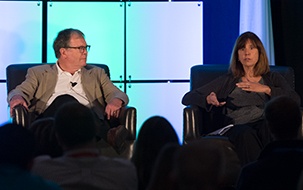Video: 3 Minutes, 3 Expert Positions on Training

In this excerpt from their 2016 Alchemy Conference presentation, three food safety experts—Doug Edmonson, Food Safety & Technology Consultant and Principal Owner at Edmonson & Associates Consulting, LeAnn Chuboff, Senior Technical Manager at SQFI, and Laura Dunn Nelson, VP Food Safety & Global Alliances at Alchemy—discuss the importance of communicating your food safety plan to employees and the need for refresher training.
Doug Edmonson: A lot of companies do a poor job of training. They give PowerPoints with a lot of acronyms and everybody leaves the room, and they don’t know or they haven’t retained what was presented. Even if it’s presented well, a lot of times it’s over the top. And I think that we’ve got to do a better job of refreshing people throughout the year. Best practices—I see a lot of companies where they’ll do 5-minute pre-shift training sessions to talk about a specific item. I think with FSMA coming in, with food fraud and a number of things, you’ve got to make sure that we’re talking down to a common language at the plant floor, so that everyone understands what the process is and why it’s important to do it.
LeAnn Chuboff: So it goes back to building that culture of food safety, and it goes back to, what are you doing to market your food safety plan to your employees? So what are you doing? Is it a poster? Is that all you’re doing? Are we looking at refreshing? Are we looking at reinforcing what our food safety plan is? What is that marketing plan to your employees? That’s what you have to think about. And if you think about that, I have a food, I want to create this food safety culture…
Doug Edmonson: An internal marketing plan…
LeAnn Chuboff: Exactly! An internal marketing plan to your employees. Let’s not just focus on meeting FSMA or meeting or getting an SQF certificate or BRC certificate, but let’s focus on what I need to put into place for food safety in my operation and how can I get my employees engaged to do this every single day.
Doug Edmonson: And I think tying that to the SOPs and the procedures that they’re doing on the floor, and why is it important that you have the right label on this package? What could happen if you get the wrong label on it? And really bringing it down to their level. What would happen to your child if this was consumed and they had an allergic reaction? So many times, I’ll walk into a plant and QA does all the training, all the monitoring, and all of the tracking of who’s been trained. I encourage you to get your HR departments involved in that and not just have them handle the OSHA or human safety training, and use outsourcing. Get some modules in that will help you do a better job of that training. And I think that I’ve seen some very good tools here at this conference with Alchemy that help assist that.
Laura Dunn Nelson: And we’re seeing that, right? People want to do more training, but the number one is resource and time, right? They don’t have it. So those kind of awareness programs, putting those imprints, those posters, those little teeny weeny modules, the digital signage, huddle guides, and the quick, those don’t take a lot of time, and they really don’t take a lot of resources.
Save the date for our 10th annual Alchemy Engage conference September 18-20, 2018 in Austin!





